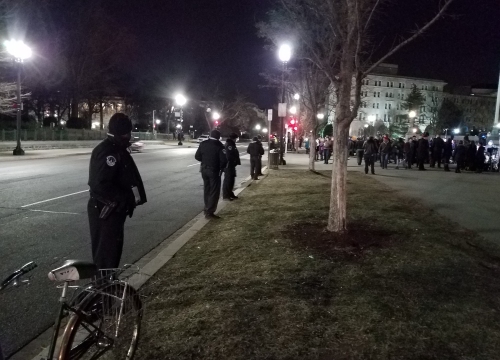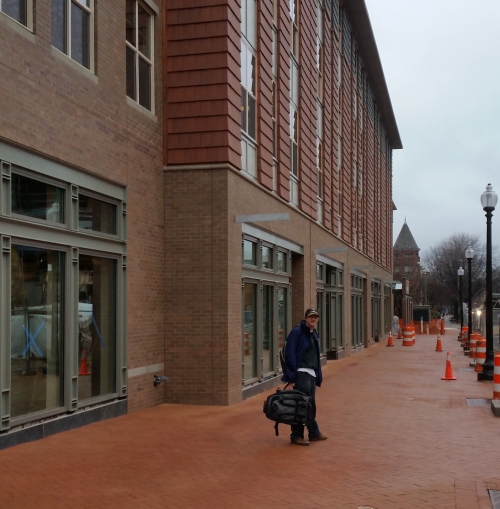
View from 3rd Street, looking northwest at the Native American Museum. Circa 11:45am. (click to enlarge)

In front of the Department of HHS on Independence Avenue, looking northeast.

6th Street looking north at the Air and Space Museum, from the railroad bridge over 6th Street.

View from 6th Street, looking north, at the Smithsonian Castle.

Our progress toward 14th Street was halted by the closed 9th Street Expressway, but going onto the Expressway allowed access to L’Enfant Plaza.

A young marcher reflects at the Department of Energy plaza.
(For Women’s March Photo Essay Part 2, click here: http://bit.ly/2jGtlz1)
The Women’s March: Impressions & Photo Essay – Part 1
by Larry Janezich
Capitol Hill Corner and a friend from Colorado spent most of Saturday near Independence Avenue at the rally portion of the Women’s March on Washington.
After failing to meet up with friends at Capitol South Metro, we made our way into the crowd via 3rd Street about 11:30am. There was a group of a half dozen red-hatted counter-protesters near Bartholdi Park, and counter counter-protesters engaging them – the only counter protesters we encountered.
At the time, it was virtually impossible to get onto Independence Avenue. It was also impossible to hear the speakers. Security in the form of an MPD presence seemed non-existent, though there were a handful of members of the National Guard in their camouflage uniforms.
The crowds were overwhelming and the organizers were not prepared. Denied permission to rally on the mall by the U.S. Park Service at the direction of the Presidential Inaugural Committee, organizers were left with the next best option offered by the DC government – the space at the intersection of Third Street and Independence. But there was nothing that was going to prevent demonstrators from spilling onto the Mall and that’s what happened. Hundreds of thousands of marchers could not get close enough to the stage or to speakers to hear the program. Parade marshals were seldom helpful, long lines developed at Porto johns, there were no cell phone or Wi-Fi signals, and the density of the crowds increased to dangerous levels – at times, we found ourselves in crowds where we could not move.
That being said, the crowd was enthusiastic and peaceful, diverse in issues, gender and age. A rough and highly subjective guess is that some 10 – 12 % of the crowd was men. Another rough guess is that some 15% was African American men and women. There were significant numbers of Asians and Latinos. There were people in wheelchairs, people with babies in strollers, people with dogs, and many children. Occasionally, a breeze carried the smell of weed. The unofficial pink “pussy hat” with points resembling feline ears were everywhere – mostly worn by women, but some by men.
We made our way toward what we thought would be the western fringe of the crowd to get near the head of the march scheduled to move along 14th Street to Constitution, then left to the dispersal point on the Ellipse, south of the White House. We tried to stay close to Independence when we could, taking advantage of the sparser populations next to the federal buildings, but occasionally being forced away from Independence and onto the side streets running away from the rally because of the dense crowds. At one point, near 12th Street, at least 50 members of Washington’s Batalá all-women Afro-Brazilian Drum Band – holding their drums over their heads – somehow made their way through the crowd.
At 1:00pm – when the march to the Ellipse was to begin – we found ourselves immobilized by the crush of bodies on 12th Street, half a block from Independence, and realized that the Avenue was entirely filled with demonstrators all the way to 14th Street. Occasionally a chain of people with a destination in mind would inch their way through the shoulder-to-shoulder crowd, holding each other’s hands or coats, fearful of being separated. Later, a young woman passing by was saying, “It’s hard to get out of a large group of people, especially when your friend has passed out from standing so long.” From somewhere behind us, there were impatient chants of “Start This March, Start This March.”
Remarkably, the Batala Drum Band came through again, having gotten stuck somewhere on the way to Independence. Back on track, the crowd parted for them like the Red Sea, hoping their presence signaled the imminent start of the march. One band member was overheard advising the member in front of her on crowd tactics: “All right, Maria, you’re going to have to be a little…pushy.”
At 1:45pm, a woman nearby who had downloaded a District Homeland Security Agency app to her phone said that she had received an alert that organizers had cancelled the march because there were too many people.
About 2:00pm, during a few seconds of Wi-Fi availability, CHC received an email alert from the Washington Post saying organizers had cancelled the march. The message had been sent half an hour earlier.
As word spread, a few people started moving back away from Independence, but some of those farther away moved forward to take their places. But the crowd loosened a little and there was a little more breathing room.
Then, with no direction, and perhaps owing to some vacancies on Independence as people began to move off, the crowd we were in began to slowly move onto and west on Independence. We moved around a Jumbotron near the Department of Agriculture. Organizers were announcing that a 12 year old girl had been separated from her family and could be reunited with them at the stage. Once we got through the east arch of the Agriculture Department building, progress came to a dead stop.
We (CHC and friend) moved along the Ag building to 14th Street and then onto the mall, where large numbers of people were arriving from points farther east on the mall and from those massed east on Independence. 14th Street was packed and completely stopped. We could see large numbers of marchers in the distance across 14th Street on the grounds of the Washington Monument. Remaining seemed to promise more of the same. Nothing had been heard from the Batala Drum Band. We walked back up the Mall to the Capitol Building.
There were contradictory reports in the news media whether a march had occurred. Some demonstrators were on the Ellipse, but from what this reporter saw, it was not part of anything you could call an organized march. It only mattered to the extent that there was no sense of closure for many of the people who had come to march to make their voices heard. But even that didn’t matter because of what they came away with: a sense of solidarity and the reassurance that they are not alone. What mattered is that they were here and participated and were counted. And with no sense of closure, the future of the rally – which could become a movement – is open.
The message on a sign carried by a young man who exited the Capitol South Metro stop this morning said it best: “Action is the antidote to despair” – Joan Baez.
































